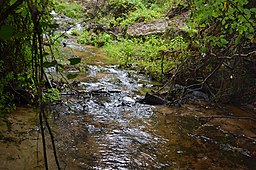| Poinsett State Park | |
|---|---|
IUCN category V (protected landscape/seascape) | |
 Shanks Creek, flowing through Poinsett State Park near Wedgefield, South Carolina | |
| Location | Sumter County, South Carolina, United States |
| Nearest city | Wedgefield, SC |
| Coordinates | 33°48′24″N 80°32′22″W / 33.80667°N 80.53944°W |
| Area | 1,010 acres (4.1 km2) |
| Established | 1934 |
| Visitors | 48,256 [1] (in fy 2006-2007) |
| Governing body | South Carolina Department of Parks, Recreation, and Tourism |
| www | |
Poinsett State Park is located in Sumter County in the U.S. state of South Carolina. The park is best known for its botanical oddities, combining the flora of the Blue Ridge Mountains foothills and Piedmont of Upstate South Carolina, the xeric Sandhills and the Atlantic coastal plain. In Poinsett State Park one can see mountain laurels draped with Spanish moss.[2][3] The park, which has been called "weird and beautiful",[2] is named after amateur botanist and South Carolina native Joel Roberts Poinsett, the first American ambassador to Mexico and popularizer of the poinsettia.[2][4] There is a $3 charge for admission to Poinsett State Park and there are small fees for overnight camping and cabin rentals. The park is surrounded by the Manchester State Forest, and both provide access to the Palmetto Trail, linked hiking and mountain bike trails, and Manchester State Forest offers equestrian trails.
- ^ Office of Research and Statistics. "State Parks Visitation (Fiscal Year 2006-07)". South Carolina Statistical Abstract. South Carolina Budget and Control Board. Archived from the original on November 10, 2010. Retrieved February 15, 2011.
- ^ a b c "Poinsett is Weird and Beautiful". The Rock Hill Herald. April 24, 1972. Retrieved February 15, 2011.
- ^ "South Carolina's Poinsett State Park" (PDF). State Parks. southcarolinaparks.com. November 21, 2008. Retrieved February 15, 2011.
- ^ Sanders, Albert E.; William D. Anderson (1999). Natural History Investigations in South Carolina from Colonial Times to the Present. University of South Carolina Press. p. 40. ISBN 978-1-57003-278-3.
